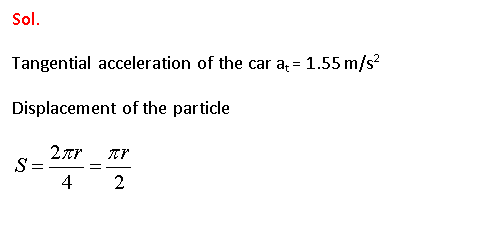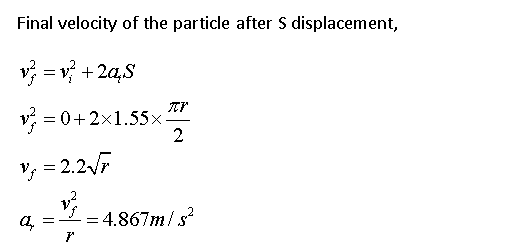
College Physics
11th Edition
ISBN: 9781305952300
Author: Raymond A. Serway, Chris Vuille
Publisher: Cengage Learning
expand_more
expand_more
format_list_bulleted
Concept explainers
Question

Transcribed Image Text:A car traveling on a flat (unbanked), circular track accelerates uniformly from rest with a tangential acceleration of 1.55 m/s2. The car makes it one quarter of the way around the circle before it skids off the track. From these data, determine the coefficient of static friction between the car and track.
Expert Solution
arrow_forward
Step 1

arrow_forward
Step 2

Trending nowThis is a popular solution!
Step by stepSolved in 4 steps with 4 images

Knowledge Booster
Learn more about
Need a deep-dive on the concept behind this application? Look no further. Learn more about this topic, physics and related others by exploring similar questions and additional content below.Similar questions
- A coin rests 14.5 cm from the center of a turntable. The coefficient of static friction between the coin and turntable surface is 0.310. The turntable starts from rest at t = 0 and rotates with a constant angular acceleration of 0.640 rad/s2. (a) Once the turntable starts to rotate, what force causes the centripetal acceleration when the coin is stationary relative to the turntable? Under what condition does the coin begin to move relative to the turntable? (b) After what period of time will the coin start to slip on the turntable? sarrow_forwardA curve in a stretch of highway has radius 512 m. The road is unbanked. The coefficient of static friction between the tires and road is 0.700. When the car enters the curve at a speed greater than the maximum safe speed (speed at which the car won’t skid), which of the following statements are correct?arrow_forwardOn a carnival ride, you stand next to a wall of a circular drum which spins around the center. When drum is spinning fast enough the floor drops away and you remain stuck to the wall and do not slide down to the floor until the drum slows down some. Assume a rider has a mass of 55.0 kg, and the drum has a radius of 6.00 m. The average linear speed that a rider is traveling with around the drum is 7.80 m/s. What is the normal force that the drum is exerting on the rider to keep her from sliding down to the floor?arrow_forward
- A 83-kg pilot in training sits in a centrifuge that spins his seat around a central axis. When the seat is moving in its circular path at a speed of 3.0 m/s, he feels a 585-N force pressing against his back (the seat faces the axis). What is the radius of the centrifuge?arrow_forwardA van with mass m = 1000 kg is driving around a circular curve of radius r = 950 m when it begins to rain. The coefficients of static friction between the track and tires is μd = 0.59 when dry and μw = 0.17 when wet. Write an expression for the maximum magnitude of the force of static friction Ff acting on the van if μs is the coefficient of friction. What is the maximum tangential speed that the van can take the corner at without slipping when dry in m/s? What is the maximum tangential speed when wet in m/s?arrow_forwardAn air puck of mass 0.30 kg is tied to a string and allowed to revolve in a circle of radius 1.3 m on a frictionless horizontal table. The other end of the string passes through a hole in the center of the table, and a mass of 1.5 kg is tied to it. The suspended mass remains in equilibrium while the puck on the tabletop revolves. (a) What is the tension in the string? N (b) What is the force causing the centripetal acceleration on the puck? (c) What is the speed of the puck? m/s Need Help? Read Itarrow_forward
- An electric fan is running on HIGH. After the speed setting is changed to LOW, the angular speed reduces to 800 rpm in 1.75 s. If the angular deceleration is a constant 42.0 rad/s², then find (a) the initial angular speed of the fan (when it was on HIGH) and (b) the number of revolutions that the fan turned through as it slowed from HIGH to LOW. (c) Include a diagram of the situation.arrow_forwardProblem 14: A rotating platform of radius R = 4.2 cm is initially at rest. It then begins to move, such that a point on its edge experiences a tangential acceleration of at = 5.5 cm/s2. Part (a) Write an expression (using variables) that gives the radial acceleration on the edge of the platform as a function of time. Part (b) Write an expression (using variables) for the time at which the magnitudes of the radial and tangential accelerations at the edge will be equal.arrow_forwardA car initially traveling at 30.2 m/s undergoes a constant negative acceleration of magnitude 1.70 m/s2 after its brakes are applied. (a) How many revolutions does each tire make before the car comes to a stop, assuming the car does not skid and the tires have radii of 0.330 m? _______ rev (b) What is the angular speed of the wheels when the car has traveled half the total distance? _______ rad/s PLEASE ANSWER ASAParrow_forward
- Riders are seated in a horizontal circle of radius 7.50 m on a carnival ride. They start from rest and accelerate uniformly for 21.0 seconds to a maximum rotational speed of 1.40 rad/s. Calculate the tangential acceleration of the riders during the first 21.0 s of the ride.arrow_forwardYou are swinging a 0.45 kg water balloon vertically. The distance from your shoulder (acting as the center of rotation) and the water balloon is about 0.70 m. You estimate the water balloon is traveling at 6.0 m/s. At the very bottom of the circular path, how much force is your hand holding the water balloon?arrow_forwardA particle of dust lands 48.8 mm from the center of a compact disc (CD) that is 120 mm in diameter. The CD speeds up from rest, and the dust particle is ejected when the CD is rotating at 98.0 revolutions per minute. What is the coefficient of static friction between the particle and the surface of the CD?arrow_forward
arrow_back_ios
SEE MORE QUESTIONS
arrow_forward_ios
Recommended textbooks for you
 College PhysicsPhysicsISBN:9781305952300Author:Raymond A. Serway, Chris VuillePublisher:Cengage Learning
College PhysicsPhysicsISBN:9781305952300Author:Raymond A. Serway, Chris VuillePublisher:Cengage Learning University Physics (14th Edition)PhysicsISBN:9780133969290Author:Hugh D. Young, Roger A. FreedmanPublisher:PEARSON
University Physics (14th Edition)PhysicsISBN:9780133969290Author:Hugh D. Young, Roger A. FreedmanPublisher:PEARSON Introduction To Quantum MechanicsPhysicsISBN:9781107189638Author:Griffiths, David J., Schroeter, Darrell F.Publisher:Cambridge University Press
Introduction To Quantum MechanicsPhysicsISBN:9781107189638Author:Griffiths, David J., Schroeter, Darrell F.Publisher:Cambridge University Press Physics for Scientists and EngineersPhysicsISBN:9781337553278Author:Raymond A. Serway, John W. JewettPublisher:Cengage Learning
Physics for Scientists and EngineersPhysicsISBN:9781337553278Author:Raymond A. Serway, John W. JewettPublisher:Cengage Learning Lecture- Tutorials for Introductory AstronomyPhysicsISBN:9780321820464Author:Edward E. Prather, Tim P. Slater, Jeff P. Adams, Gina BrissendenPublisher:Addison-Wesley
Lecture- Tutorials for Introductory AstronomyPhysicsISBN:9780321820464Author:Edward E. Prather, Tim P. Slater, Jeff P. Adams, Gina BrissendenPublisher:Addison-Wesley College Physics: A Strategic Approach (4th Editio...PhysicsISBN:9780134609034Author:Randall D. Knight (Professor Emeritus), Brian Jones, Stuart FieldPublisher:PEARSON
College Physics: A Strategic Approach (4th Editio...PhysicsISBN:9780134609034Author:Randall D. Knight (Professor Emeritus), Brian Jones, Stuart FieldPublisher:PEARSON

College Physics
Physics
ISBN:9781305952300
Author:Raymond A. Serway, Chris Vuille
Publisher:Cengage Learning

University Physics (14th Edition)
Physics
ISBN:9780133969290
Author:Hugh D. Young, Roger A. Freedman
Publisher:PEARSON

Introduction To Quantum Mechanics
Physics
ISBN:9781107189638
Author:Griffiths, David J., Schroeter, Darrell F.
Publisher:Cambridge University Press

Physics for Scientists and Engineers
Physics
ISBN:9781337553278
Author:Raymond A. Serway, John W. Jewett
Publisher:Cengage Learning

Lecture- Tutorials for Introductory Astronomy
Physics
ISBN:9780321820464
Author:Edward E. Prather, Tim P. Slater, Jeff P. Adams, Gina Brissenden
Publisher:Addison-Wesley

College Physics: A Strategic Approach (4th Editio...
Physics
ISBN:9780134609034
Author:Randall D. Knight (Professor Emeritus), Brian Jones, Stuart Field
Publisher:PEARSON